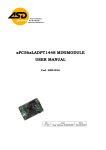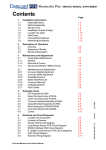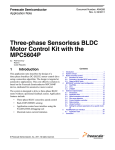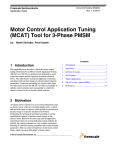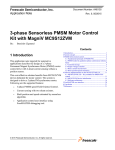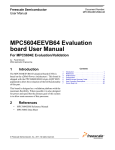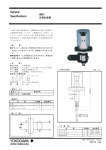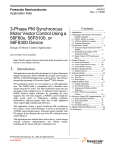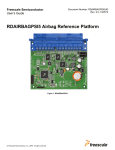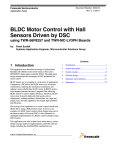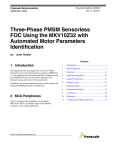Download Application Note - Freescale Semiconductor
Transcript
Freescale Semiconductor
Application Note
Document Number: AN4561
Rev. 1, 11/2015
3-Phase PMSM Motor Control Kit
with the MPC5604P
by:
Roman Filka and Marek Stulrajter
Contents
1 Introduction
1
Introduction................................................................1
This application note describes the design of a 3-phase
Permanent Magnet Synchronous Motor (PMSM) vector
control drive with 3-shunt current sensing with a position
sensor. The design is targeted for automotive applications.
This cost-effective solution benefits from a Freescale
Semiconductor MPC5604P device dedicated for motor
control.
2
System concept.......................................................... 1
3
PMSM field oriented control............. ....................... 2
4
MPC5604P- CB configuration.......... ........................7
5
Software design....................................................... 13
6
Application control user interface....... ....................23
The system is designed to drive a 3-phase PM synchronous
motor. Application features:
• 3-phase PMSM speed Field Oriented Control.
• Current sensing with three shunt resistors.
• Support for encoder and resolver position transducers.
• Application control user interface using FreeMASTER
debugging tool.
• Motor Control Application Tuning (MCAT) tool
7
References.............................. ................................. 26
8
Revision history.......................... ............................ 26
2 System concept
The system is designed to drive a 3-phase PM synchronous
motor. The application meets the following performance
specifications:
• Targeted at the MPC5604P Controller (refer to
dedicated user manual for MPC5604P found at
www.freescale.com), see References for more
information
© 2015 Freescale Semiconductor, Inc.
PMSM field oriented control
• Running on the MPC5604P Control Drive board (refer to dedicated user manual for MPC5604P Controller Board), see
References for more information
• Control technique incorporating:
• Vector control of 3-phase PM synchronous motor with position sensor
• Closed-loop speed control
• Bi-directional rotation
• Both motor and generator modes
• Close-loop current control
• Flux and torque independent control
• Start up with alignment
• Reconstruction of three-phase motor currents from two shunt resistors
• 100 μs sampling period with FreeMASTER recorder
• FreeMASTER software control interface (motor start/stop, speed setup), see References for more information
• FreeMASTER software monitor
• FreeMASTER software graphical control page (required speed, actual motor speed, start/stop status, DC-Bus
voltage level, motor current, system status)
• FreeMASTER software speed scope (observes actual and desired speeds, DC-Bus voltage and motor current)
• FreeMASTER software high-speed recorder (reconstructed motor currents, vector control algorithm quantities)
• DC-Bus over-voltage and under-voltage, over-current, overload and start-up fail protection
• Motor Control Application Tuning (MCAT) tool (see References)
• The MCAT tool is a user-friendly graphical FreeMASTER’s plug-in tool for debugging and tuning of motorcontrol applications
3 PMSM field oriented control
3.1 Fundamental principle of PMSM FOC
High-performance motor control is characterized by smooth rotation over the entire speed range of the motor, full torque
control at zero speed, and fast acceleration/deceleration. To achieve such control, vector control techniques are used for PM
synchronous motors. The vector control techniques are usually also referred to as field-oriented control (FOC).
The FOC concept is based on an efficient torque control requirement, which is essential for achieving a high control
dynamic. Analogous to standard DC machines, AC machines develop maximal torque when the armature current vector is
perpendicular to the flux linkage vector. Thus, if only the fundamental harmonic of stator-mmf is considered, the torque Te
developed by an AC machine, in vector notation, is given by:
Equation 1. Electric motor torque
where pp is the number of motor pole-pairs, is is stator current vector and ψs represents vector of the stator flux. Constant 3/2
indicates a non-power invariant form of transformation used.
In instances of DC machines, the requirement to have the rotor flux vector perpendicular to the stator current vector is
satisfied by the mechanical commutator. Because there is no such mechanical commutator in AC Permanent Magnet
Synchronous Machines (PMSM), the functionality of the commutator has to be substituted electrically, by enhanced current
control. This suggests orientating the stator current vector in so that the component of stator current magnetizing the machine
(flux component) is isolated from the torque producing component.
3-Phase PMSM Motor Control Kit with the MPC5604P, Rev. 1, 11/2015
2
Freescale Semiconductor, Inc.
PMSM field oriented control
This can be accomplished by decomposing the current vector into two components projected in the reference frame, often
called the dq frame, that rotates synchronously with the rotor. It has become standard to position the dq reference frame such
that the d-axis is aligned with the position of the rotor flux vector, so that the current in the d-axis will alter the amplitude of
the rotor flux linkage vector. The reference frame position must be updated so that the d-axis will be always aligned with the
rotor flux axis.
Because the rotor flux axis is locked to the rotor position, when using PMSM machines, a mechanical position transducer can
be utilized to measure the rotor position and the position of the rotor flux axis. When the reference frame phase is set such
that the d-axis is aligned with the rotor flux axis, the current in the q-axis represents solely the torque producing current
component.
What further results from setting the reference frame speed to be synchronous with the rotor flux axis speed is that both d and
q axis current components are DC values. This implies utilization of simple current controllers to control the demanded
torque and magnetizing flux of the machine, thus simplifying the control structure design.
Figure 1 shows the basic structure of the vector control algorithm for the PM synchronous motor. To perform vector control,
it is necessary to perform these steps:
• Measure the motor quantities (phase voltages and currents, rotor speed and position).
• Transform them into the two-phase system (α, β) using a Clarke transformation.
• Transform stator currents into the d, q reference frame using a Park transformation.
Also keep these points in mind:
• The stator current torque (isq) and flux (isd) producing components are separately controlled.
• The output stator voltage space vector is calculated using the decoupling block.
• The stator voltage space vector is transformed by an inverse Park transformation back from the d, q reference frame
into the two-phase system fixed with the stator.
• The output three-phase voltage is generated using a space vector modulation.
To be able to decompose currents into torque and flux producing components ( isd, isq), position of the motor-magnetizing
flux has to be known. This requires accurate sensing of the rotor position and velocity. Incremental encoders or resolvers
attached to the rotor are naturally used as position transducers for vector control drives.
Figure 1. Field oriented control transformations
3.2 PMSM model in quadrature phase synchronous reference
frame
Quadrature phase model in synchronous reference frame is very popular for field oriented control structures, because both
controllable quantities, current and voltage, are DC values. This allows to employ only simple controllers to force the
machine currents into the defined states. Furthermore full decoupling of the machine flux and torque can be achieved, which
allows dynamic torque, speed and position control.
The equations describing voltages in the three phase windings of a permanent magnet synchronous machine can be written in
matrix form as follows:
3-Phase PMSM Motor Control Kit with the MPC5604P, Rev. 1, 11/2015
Freescale Semiconductor, Inc.
3
PMSM field oriented control
Equation 2. Three phase voltage model of AC motor
where the total linkage flux in each phase is given as:
Equation 3. PMSM total linkage flux matrix
where Laa, Lbb, Lcc, are stator phase self inductances and Lab=Lba, Lbc=Lcb, Lca=Lac are
mutual inductance between respective stator phases. The term ψPM represents the magnetic
flux generated by the rotor permanent magnets, and θe is electrical rotor angle.
Figure 2. Orientation of stator(stationary) and rotor(rotational) reference frames, with
current components transformed into both frames.
The voltage equation of the quadrature phase synchronous reference frame model can be obtained by transforming the three
phase voltage equations (Equation 1 on page 2, Equation 2 on page 3) into a two phase rotational frame which is aligned and
rotates synchronously with the rotor as shown in Figure 2. Such transformation, after some mathematical corrections, yields
the following set of equations:
Equation 4. DQ voltage model of PMSM
It can be seen that Equation 4 on page 4 represents a non-linear cross dependent system, with cross-coupling terms in both d
and q axis and back-EMF voltage component in the q-axis. When FOC concept is employed, both cross-coupling terms shall
be compensated in order to allow independent control of current d and q components. Design of the controllers is then
governed by following pair of equations, derived from Equation 4 on page 4 after compensation:
Equation 5. D axis voltage
3-Phase PMSM Motor Control Kit with the MPC5604P, Rev. 1, 11/2015
4
Freescale Semiconductor, Inc.
PMSM field oriented control
Equation 6. Q axis voltage
which describes the model of the plant for d and q current loop. It is obvious that both Equation 5 on page 4 and Equation 6
on page 4 are structurally identical, therefore the same approach of controller design can be adopted for both d and q
controllers. The only difference is in values of d and q axis inductances, which results in different gains of the controllers.
Considering closed loop feedback control of a plant model as in Equation 5 on page 4 or Equation 6 on page 4, using
standard PI controllers, then the controller proportional and integral gains can be derived, using a pole-placement method, as
follows:
Equation 7. Proportional gain equation
Equation 8. Integral gain equation
where ω0 represents the system natural frequency [rad/sec] and ζ is the Damping factor [-]
of the current control loop.
3.3 Phase current measurement
The 3-phase voltage source inverter depicted in Figure 3 uses three shunt resistors (R32, R31 and R32) placed in each of the
inverter leg as phase current sensors. Stator phase current which flows through the shunt resistor produces a voltage drop
which is interfaced to the AD converter of microcontroller through conditional circuitry (refer to “3-Phase BLDC/PMSM
Low Voltage Power Stage - User Manual”).
Figure 3. 3-phase DC/AC inverter with shunt resistors for current measurement
Figure 4 shows an operational amplifier and input signal filtering circuit which provides the conditional circuitry and adjusts
voltages to fit into the ADC input voltage range.
3-Phase PMSM Motor Control Kit with the MPC5604P, Rev. 1, 11/2015
Freescale Semiconductor, Inc.
5
PMSM field oriented control
Figure 4. Phase current measurement conditional circuitry
The phase current sampling technique is a critical issue for detection of phase current differences and for acquiring full three
phase information of stator current by its reconstruction. Phase current flowing through shunt resistors produces a voltage
drop which needs to be appropriately sampled by the AD converter when low-side transistors are switched on. The current
cannot be measured by the current shunt resistors at an arbitrary moment. This is because that the current only flows through
the shunt resistor when the bottom transistor of the respective inverter leg is switched on. Therefore considering the diagram
depicted in Figure 3, phase A current is measured using the R30 shunt resistor and can only be sampled when the transistor
Q5 is switched on. Correspondingly, the current in phase B can only be measured if the transistor Q6 is switched on, and the
current in phase C can only be measured if the transistor Q7 is switched on. In order to get an actual instant of current
sensing, voltage waveform analysis has to be performed.
Generated duty cycles (phase A, phase B, phase C) of two different PWM periods are depicted in Figure 5. These phase
voltage waveforms correspond to a center-aligned PWM with sinewave modulation. As shown in the following figure,
(PWM period I), the best sampling instant of phase current is in the middle of the PWM period, where all bottom transistors
are switched on. However, not all three currents can be measured at an arbitrary voltage shape. PWM period II in the
following figure shows a case when the bottom transistor of phase A is on for a very short time. If the on time is shorter than
a certain critical time (depends on h/w design), the current cannot be correctly measured.
3-Phase PMSM Motor Control Kit with the MPC5604P, Rev. 1, 11/2015
6
Freescale Semiconductor, Inc.
MPC5604P- CB configuration
Figure 5. Generated phase duty cycles in different PWM periods.
In case of standard motor operation where the supplied voltage is generated using the space vector modulation, the sampling
instant of phase current takes place in the middle of the PWM period in which all bottom transistors are switched on. If the
modulation index of applied SVM technique increases there is an instant when one of the bottom transistors is switched on
for a very short time period. Therefore, only two currents are measured and the third one is calculated from equation:
Equation 9. Currents in three phase balanced system
Therefore, a minimum on time of the low-side switch is required for three phase current reconstruction.
4 MPC5604P- CB configuration
The PMSM Speed Field Oriented Control framework application software and hardware is designed to meet the following
technical specifications:
• MPC5604P Controller Board is used (refer to dedicated user manual for MPC5604P Controller Board)
• 3-phase low voltage power stage with MC33937 pre-driver is used
• refer to dedicated user manual for 3-phase low voltage power-stage with MC33937 pre-driver. See References for
more information.
• refer to dedicated user manual for MC33937 pre-driver on www.freescale.com
• refer to dedicated document describing communication with and configuration of MC33937 pre-driver using
DSPI communication bus
• PWM output frequency = 20 kHz
• current loop sampling period = 100 µs
• speed loop sampling period = 2 ms
• 3-phase current measurement using three shunt resistors on bottom side of each inverter leg. Phase current
measurement feedback is routed to ADC0 and ADC1 as follows:
• phase A current: ADC0/1 - CH12
• phase B current: ADC0/1 - CH13
• phase C current: ADC0/1 - CH14
• DC bus voltage measurement routed to ADC1 as follows:
• DC bus voltage: ADC1 - CH0
• encoder position feedback routed to eTimer1 module as follows:
• phase A: eTimer1 - CH1 input
• phase B: eTimer1 - CH2 input
3-Phase PMSM Motor Control Kit with the MPC5604P, Rev. 1, 11/2015
Freescale Semiconductor, Inc.
7
MPC5604P- CB configuration
• resolver excitation signal routed from eTimer0 - CH5
• resolver position feedback routed to ADC0 and ADC1 as follows:
• resolver sin: ADC0 - CH1
• resolver cos: ADC1 - CH1
4.1 FlexPWM
The MPC5604P Clock Generation Module is configured to generate a clock signal of 120 MHz on the MC_PLL_CLK bus.
The FlexPWM module is clocked from the MC_PLL_CLK, therefore it is placed behind the IPS Bus Clock Sync Bridge.
The FlexPWM sub-module #0 is configured to run as a master and to generate Master Reload Signal (MRS) and counter
synchronization signal (master sync) for other sub-modules. The MRS signal is generated every second opportunity of submodule #0, VAL1 compare, i.e. full cycle reload. All double buffered registers, including compare registers VAL2, VAL3,
VAL4, VAL5 are updated on occurrence of MRS, therefore update of new PWM duty cycles is done every two PWM
periods.
FlexPWM modulo counting, for generation of centrr-aligned PWM signals, is achieved by setting VAL0 register to zero and
INIT register to negative value of VAL1. Considering PWM clock of 120 MHz, required PWM output 20 kHz and PWM
reload period 100 µs, then INIT, VAL0 and VAL1 registers of sub-modules 0,1,2 are set as follows:
• INIT = -120000000/20000/2 = -3000 DEC = 0xF448
• VAL0 = 0 DEC
• VAL1 = - INIT = 3000 DEC = 0x0BB8
Reload frequency of sub-modules 0,1,2 is set to "Every two opportunities" and "Full cycle reload" is enabled in all submodules. Because sub-module #0 is a master that generates MRS signal, reload of double buffered registers of sub-module #0
is done on "Local Reload". Sub-modules 1 and 2 are slaves, so reload of their double buffered registers is done on "Master
Reload", broadcast from sub-module #0. Similarly, the sub-module #0 counter is initialized on "Local Sync" event, while
sub-modules 1 and 2 on "Master Sync" event, which is also broadcast from sub-module #0.
Because some registers are double buffered on occurrence of FORCE OUT signal, all sub-modules have "Local Reload"
event selected as force source.
All PWM channels are used to drive a 3-phase DC/AC inverter, so each PWM pair is driven in complementary mode, with
dead-time automatically added on each rising edge of respective PWM signal. Used power stage with MC33937 pre-driver
inverts the polarity of PWM signals for top transistors (active low logic), so PWM A output polarity in all sub-modules is set
as "Inverted". Therefore, during fault state, the output of PWM A of each sub-module is set to logic one.
The FlexPWM module includes a Fault Protection logic, which can control any combination of PWM output pins and
automatically disable PWM outputs during a fault state. Faults are generated by a logic one on any of the FAULTx pins. In
order to enable mapping of all fault pins, fault disable mapping registers (DISMAP) of all sub-modules must be enabled
(logic one).
4.2 CTU
The MRS signal generated from the FlexPWM module is internally routed to the CTU module, where it is selected using the
input selection register Trigger Generator Subunit Input Selection Register (TGSISR) as source of master reload signal for
CTU. This signal is used for reload trigger compare registers, and reloads the TGS counter with the value stored in TGS
counter reload register. The TGS counter register is used to compare the current counter value with the values of trigger
compare registers, when the two values are the same an event is generated. TGS is configured in triggered mode.
Because the MRS signal is generated every two PWM periods, the CTU counter can count up to value of 12000DEC when
the initial value is set to zero.
The following TGS trigger compare registers are used for trigger events:
• T0CR = 0x0 (=0 DEC)
3-Phase PMSM Motor Control Kit with the MPC5604P, Rev. 1, 11/2015
8
Freescale Semiconductor, Inc.
MPC5604P- CB configuration
• 1 T1CR = 0x099C (=2460 DEC)
• 1T2CR = 0x210C (= 8460 DEC)
• 1T3CR = 0x2DF0 (=11760)
The CTU Scheduler subUnit (SU) generates the trigger event output according to the trigger event that occurred. The
following trigger event outputs are generated:
• ADC command output: T0CR generates ADC command event output, with command offset initially set to one. It is
used as synchronization signal to ADC (ADC commands #1 - #12 for phase current and DC bus voltage measurement).
• 2 eTimer0 output: T1CR generates eTimer0 event output, which toggles its output to generate rising edge of resolver
exciting signal.T1CR is phase shifted to account for delay caused by the MPC5604P resolver hardware circuitry and to
allow ADC sampling of resolver signals just before PWM reload.
• 2eTimer0 output: T2CR generates eTimer0 event output, which toggles its output to generate falling edge of the
resolver exciting signal; frequency of resolver exciting signal is: resolverSignalFreq = MC_PLL_CLK/(2*(T2CRT1CR)) = 120000000/(2*(8460-2460))=10kHz
• 2ADC command output: T3CR generates ADC command event output, with command offset set to zero. It is used as
synchronization signal to ADC (ADC command #0 for resolver signals sampling)
The SU uses a Commands List in order to select the command to send to the ADC when a trigger event occurs. Each ADC
command sent by the CTU into the ADC specifies:
• whether the actual command is a first command of a new stream of consecutive commands or not
• whether an End Of Conversion (EOC) interrupt is issued when conversion specified by the command is finished
• which channels are to be converted for both ADC modules
• the target FIFO register for storing the conversion results
Because the trigger compare register for trigger T0CR is set to zero, it generates the ADC start of conversion request at the
beginning of each PWM reload cycle. When a T0CR trigger event occurs, the ADC command selected by the index value
T0_INDEX in command list control registers CLCR1 is sent to the ADC.
At each T0CR trigger event, two ADC commands are executed in a stream. The first command in a stream specifies two
phase currents to be sampled simultaneously (all phase current signals are routed to pins shared between both ADC modules).
The second command specifies the third phase current and DC bus voltage to be sampled.
The index pointer to the ADC command list T0_INDEX is updated according to the sector in which resides the actual output
voltage vector, calculated by the space vector modulation of the FOC algorithm. There are six sectors within the output
voltage hexagon of the inverter, therefore six different ADC command sequences are selected for one full revolution of the
voltage vector. This technique is necessary when the phase current measurement is done using three shunt resistors placed in
the bottom side of each inverter leg.
Because the shunt resistor is placed at the bottom side of the inverter leg, the phase current can be measured only when
bottom transistor is switched on. Because the sum of the three currents in the motor windings is zero, only two currents are
measured and the third one is calculated. Which phases are measured and which are calculated changes according to the
voltage vector angle, i.e. the phases with the largest PWM on-pulse on the bottom transistors are selected to get the best
current information.
Configuration of CTU ADC commands is shown in Figure 6.
1. These triggers are only necessary when using resolver position sensor.
2. These trigger event outputs are only necessary when using resolver position sensor.
3-Phase PMSM Motor Control Kit with the MPC5604P, Rev. 1, 11/2015
Freescale Semiconductor, Inc.
9
MPC5604P- CB configuration
Figure 6. Configuration of CTU ADC commands for the PMSM FOC application
4.3 eTimer0
This eTimer module is only used for generation of an excitation signal for resolver. Because of hardware design, channel #5
of this eTimer module is selected. The purpose is to generate a square wave signal with a frequency of 10 kHz, which is then
processed by a hardware low pass filter designed on used controller board. Because of the low pass filter, the resulting
harmonic signal is phase shifted.
In order to generate a square wave signal synchronized with the MRS signal, timer channel #5 of module eTimer0 (eTimer1ETC[5]) is configured as follows:
• counting mode - "Edge of secondary source triggers primary count until compare"
• count direction - "Count up"
• primary source - "IPBus clock"
• secondary source - "AUX #0", which is an output signal from CTU ETIMER #0 trigger event output
3-Phase PMSM Motor Control Kit with the MPC5604P, Rev. 1, 11/2015
10
Freescale Semiconductor, Inc.
MPC5604P- CB configuration
•
•
•
•
•
•
•
•
count stop mode - "Count repeatedly"
count length - "Count until compare then reinitialize"
compare mode - "Use COMP1 when counting up and COMP2 when counting up"
output mode - "Toggle OFLAG on successful compare with COMP1 and/or COMP2"
COMP1 = 0x0
COMP2 = 0x0
LOAD = 0x0
direction of the channel pin - "Output - OFLAG"
4.4 eTimer1
This eTimer module is only used for decoding two square-wave signals from an encoder. Because of hardware design,
channel #0 of this eTimer module is selected. The purpose is to decode the two 90°-shifted square wave signals and count up
or down all rising/falling edges based on their sequences. The software routine then reads the associated counter value to get
the information about rotor position. Reading of the counter value is performed from within POSPE_GetPositionElEnc()
function, periodically within CTU-ADC interrupt service routine. See the data flow diagram shown in Figure 10.
In order to decode the encoder signals, timer channel #0 of module eTimer1 (eTimer1-ETC[0]) is configured as follows:
• counting mode - "Quadrature count mode, uses primary and secondary sources"
• count direction - "Count up"
• primary source - "Counter #1 input"
• secondary source - "Counter #2 input"
• count stop mode - "Count repeatedly"
• count length - "Count until compare then reinitialize"
• preload control for CNTR
• "Load CNTR with CMPLD1 upon successful compare with COMP2"
• "Load CNTR with CMPLD2 upon successful compare with COMP1"
• compare mode - "Use COMP1 when counting up and COMP2 when counting down"
• output mode - "Toggle OFLAG on successful compare with COMP1 and/or COMP2"
• COMP1 = 0x07FF (2047 DEC)
• COMP2 = 0xF800 (-2048 DEC)
• CMPLD1 = 0x07FF (2047 DEC)
• CMPLD2 = 0xF800 (-2048 DEC)
• LOAD = 0x0, this value is updated by a software routine during ALIGN phase
The compare registers of eTimer0 channel #0 are set according to the number of encoder pulses per one mechanical
revolution. In this case, an encoder sensor with 1024 pulses is used. Considering quadrature mode, the encoder has a
capability of position recognition with a precision that is four times higher than the number of pulses in the application, for a
maximum number of edges of 4096. The compare registers are calculated as follows:
• COMP1 = 4096/2 - 1 = 0x07FF (2047 DEC)
• COMP2 = -4096/2 = 0xF800 (-2048 DEC)
4.5 On-chip motor control peripherals interconnection
3-Phase PMSM Motor Control Kit with the MPC5604P, Rev. 1, 11/2015
Freescale Semiconductor, Inc.
11
MPC5604P- CB configuration
Figure 7. MPC5604P motor control peripherals connection
4.6 ADC conversion and interrupt timing
Configuration of FlexPWM, CTU and eTimer0 peripheral modules, as described in FlexPWM, CTU, and eTimer0, results in
a sequence of trigger/events that are shown in the following figure. The application state machine functions are called from
an interrupt service routine, which is associated with CTU-ADC command interrupt request. As can be seen from ADC
command list configuration, shown in Figure 6, the ADC command interrupts are linked with CTU trigger T0CR, in other
words, when measurement of phase currents and DC bus voltage is finished.
3-Phase PMSM Motor Control Kit with the MPC5604P, Rev. 1, 11/2015
12
Freescale Semiconductor, Inc.
Software design
Figure 8. FlexPWM-CTU-ADC conversion timing
5 Software design
5.1 Introduction
This section describes the software design of the PMSM Field Oriented Control framework application. First, the application
overview and description of software implementation are provided. Then the numerical scaling in fixed-point fractional
arithmetic of the controller is discussed, followed by a detailed description of speed and current sensing. The aim of this
chapter is to help in understanding of the designed software.
5.2 Application data flow overview
The application software is interrupt driven running in real time. There is one periodic interrupt service routine associated
with the CTU-ADC command interrupt request, executing all motor control tasks. These include both fast, current, and slow
speed loop control. All tasks are performed in an order described by the application state machine shown in Figure 11, and
application flowcharts shown in Figure 9 and Figure 10.
3-Phase PMSM Motor Control Kit with the MPC5604P, Rev. 1, 11/2015
Freescale Semiconductor, Inc.
13
Software design
Figure 9. Flow chart diagram of main function with background loop.
To achieve precise and deterministic sampling of analog quantities and to execute all necessary motor control calculations,
the state machine functions are called within a periodic interrupt service routine. Hence in order to actually call state machine
functions the periphery causing this periodic interrupt must be properly configured and the interrupt enabled. As is described
later, all peripherals are initially configured and all interrupts are enabled within a state RESET of the state machine.
Therefore state machine is called once in main function before the background loop to enter RESET state and to enable
interrupts. As soon as interrupts are enabled and all peripheries are correctly configured (see MPC5604P- CB configuration
for configuration of peripherals), the state machine functions are called from the CTU-ADC interrupt service routine. The
background loop handles non-critical timing tasks, such as the FreeMASTER communication polling.
3-Phase PMSM Motor Control Kit with the MPC5604P, Rev. 1, 11/2015
14
Freescale Semiconductor, Inc.
Software design
Figure 10. Flow chart diagram of periodic interrupt service routine.
5.3 State machine
The application state machine is implemented using a two-dimensional array of pointers to the functions variable called
state_table[][](). The first parameter describes the current application event, and the second parameter describes the
actual application state. These two parameters select a particular pointer to state machine function, which causes a function
call whenever state_table[][]() is called.
3-Phase PMSM Motor Control Kit with the MPC5604P, Rev. 1, 11/2015
Freescale Semiconductor, Inc.
15
Software design
Figure 11. Application state machine
The application state machine consists of following seven states, which are selected using variable state defined as
AppStates:
•
•
•
•
•
•
•
RESET - state = 0
INIT - state = 1
FAULT - state = 2
READY - state = 3
CALIB - state = 4
ALIGN - state = 5
RUN - state = 6
To signalize/initiate a change of state, thirteen events are defined, and are selected using variable event defined as
AppEvents:
•
•
•
•
•
•
•
•
•
•
•
•
•
e_reset - event = 0
e_reset_done - event = 1
e_fault - event = 2
e_fault_clear - event = 3
e_init_done - event = 4
e_ready - event = 5
e_app_on - event = 6
e_app_off - event = 12
e_calib - event = 7
e_calib_done - event = 8
e_align - event = 9
e_align_done - event = 10
e_run - event = 11
3-Phase PMSM Motor Control Kit with the MPC5604P, Rev. 1, 11/2015
16
Freescale Semiconductor, Inc.
Software design
5.4 State – RESET
State RESET is the first state the state machine enters after power on or reset, in other words, when the application enters
main() function. In RESET state, all used peripherals are reset and configured as required by the application (see MPC5604PCB configuration). Before configuring peripheral modules, all interrupts are disabled. Interrupts are enabled at the end of
RESET state. Therefore, the periodic CTU-ADC interrupt is not requested, and the state machine functions cannot be
executed until all interrupts are enabled and all peripherals set.
State RESET is a "one pass" function/state. It is entered and executed only once, and the next state is called after RESET is
finished. If there is no error/fault during RESET execution, the application event is set to event=e_reset_done and all
interrupts are enabled at the end of the function. From this point, the CTU-ADC interrupts are enabled, and if the peripherals
are correctly configured, the next call of state machine function will be from within the CTU-ADC interrupt service routine.
According to the data flow diagram of the CTU-ADC interrupt service routine, shown in Figure 10, the routine for three
phase current reconstruction ADC_Measure2Ph() is executed first, followed by the rotor position measurement routine. The
fault detection function is always called before the state machine function call, ensuring correct transition to FAULT state in
case a fault is detected. If there is no fault detected, the application event remains set to event=e_reset_done, hence INIT
state will be selected as the next state to execute.
The user can initiate a jump to RESET state from any state of the state machine by setting the event to event=e_reset.
This is done by setting switchAppReset variable to true using FreeMASTER. The entire RESET procedure as described
above is then repeated. The following sequence is performed in this order:
• interrupts disable
• all peripherals reset and configure
• user control and fault variables reset
switchAppOnOff
= false;
switchAppOnOffState
= false;
switchFaultClear
= false;
switchAppReset
= false;
faultID.R
= 0x0;
faultIDp.R
= 0x0;
• event set to event=e_reset_done
• interrupts enable
5.5 State – FAULT
The application goes immediately to this state when a fault is detected. The system allows all states to pass into the FAULT
state by seting event = e_fault. State FAULT is a state that allows transition back to itself if a fault is present in the
system and the user does not request clearing of fault flags.
There are two different variables to signal fault occurrence in the application. The actual fault register faultID represents
the current state of the fault pin/variable etc., and the pending fault register faultIDp represents a fault flag, which is set
once actual fault is/was true. Even if the actual fault is reset (fault source disappears), the pending fault remains set until
manually cleared by the user. Such mechanisms allow for stopping the application and analyzing the cause of failure, even if
the fault was caused by a short glitch on monitored pins/variables.
State FAULT can only be left when application variable switchFaultClear is manually set to true (using FreeMASTER).
That is, the user has acknowledged that the fault source has been removed and the application can be restarted. When the user
sets switchFaultClear = true; the following sequence is automatically executed:
faultID.R
faultIDp.R
switchFaultClear
event
=
=
=
=
0x0;
0x0;
false;
e_fault_clear;
//
//
//
//
Clear Fault register
Clear Pending Fault register
Reset fault clearing switch
new application event
3-Phase PMSM Motor Control Kit with the MPC5604P, Rev. 1, 11/2015
Freescale Semiconductor, Inc.
17
Software design
Seting event to event = e_fault_clear while in FAULT state represents a new request to proceed to INIT state. This
request is purely user action and does not depend on actual fault status. In other words, it is up to the user to decide when to
set switchFaultClear true). However, according to the interrupt data flow diagram shown in Figure 10, function
faultDetection() is called before state machine function state_table[event][state](). Therefore, all faults will
be checked again and if there is any fault condition remaining in the system, the respective bits in faultID and faultIDp
variables will be set. As a consequence of faultID and faultIDp not equal to zero, function faultDetection() will
modify the application event from e_fault_clear back to e_fault, which means jump to fall state when state machine
function state_table[event][state]() is called. Hence, INIT state will not be entered even though the user tried to
clear the fault flags using switchFaultClear.
When the next state (INIT) is entered, all fault bits are cleared, which means no fault is detected (faultIDp.R = 0x0) and
application variable switchFaultClear is manually set to true.
5.5.1 Application faults
Both faultID and faultIDp are defined as AppFaultStatus, which is a 32 bit long data type. Application faults are bit
mapped in AppFaultStatus type as follows:
Table 1. AppFaultStatus type
31
30
29
FLT
FLT
FLT
31
30
29
15
14
13
12
11
10
FLT
FLT
FLT
FLT
FLT
FLT
15
14
13
12
11
10
•
•
•
•
•
•
•
•
•
•
•
•
•
•
•
•
•
•
•
•
•
•
•
•
28
27
26
25
24
23
22
21
FLT
FLT
FLT
FLT
24
23
22
21
9
8
7
6
5
4
FLT9
FLT8
FLT7
FLT6
FLT5
FLT4
RESERVED
20
19
18
17
16
FLT
FLT
FLT
18
17
16
3
2
1
0
FLT3
FLT2
FLT1
FLT0
RESERVED
FLT0 - OverDCBusVoltage (Over-voltage on DC bus)
FLT1 - UnderDCBusVoltage (Under-voltage on DC bus)
FLT2 - OverDCBusCurrent (Over-current on DC bus)
FLT3 - OverLoad (Overload Flag)
FLT4 - MainsFault (Mains out of range)
FLT5 - WrongHardware (Wrong hardware fault flag)
FLT6 - OverHeating (Overheating fault flag)
FLT7 - OverPhaseACurrent (Over-current on phase A)
FLT8 - OverPhaseBCurrent (Over-current on phase B)
FLT9 - OverPhaseCCurrent (Over-current on phase C)
FLT10 - OffCancError (Offset cancellation error)
FLT11 - MC33937_TLIM (over temperature) - not used in current software version
FLT12 - MC33937_DESAT (desaturation detected) - not used in current software version
FLT13 - MC33937_VLS (low VLS detected) - not used in current software version
FLT14 - MC33937_OC (over current detected) - not used in current software version
FLT15 - MC33937_PhaseE (phase error) - not used in current software version
FLT16 - MC33937_FrameE (SPI communication frame error) - not used in current software version
FLT17 - MC33937_WriteE (SPI communication write error) - not used in current software version
FLT18 - MC33937_RST (reset event) - not used in current software version
FLT21 - FOCError (error in FOC calculation function)
FLT22 - AlignError (error during alignment)
FLT23 - CalibError (error during ADC calibration)
FLT24 - InitError (error during app initialization)
FLT29 - FLEXPWM_Error (error in FlexPWM hardware initialization)
3-Phase PMSM Motor Control Kit with the MPC5604P, Rev. 1, 11/2015
18
Freescale Semiconductor, Inc.
Software design
• FLT30 - ADC_Error (error in ADC hardware initialization)
• FLT31 - CTU_Error (error in CTU hardware initialization)
5.6 State – INIT
State INIT is similar to state RESET "one pass" state/function, and can be entered from all states except for READY state,
provided there are no faults detected. All application variables and parameters are initialized in state INIT.
After the execution of INIT state, the application event is automatically set to event=e_init_done, and state READY is
selected as the next state to enter.
5.7 State – CALIB
In this state, ADC DC offset calibration is performed. Once the state machine enters CALIB state, all PWM output are
enabled.
Calibration of the DC offset is achieved by generating 50% duty-cycle on the PWM outputs, and taking several
measurements of all configured ADC channels. These measurements are then averaged, and the average value for each
channel is stored. This value will be subtracted from the measured value when in normal operation. This way the half range
DC offset, caused by voltage shift of 1.65V in conditional circuitry (see Figure 4), is removed in all three phases.
State CALIB is a state that allows transition back to itself, provided no faults are present, the user does not request RESET
(by switchAppReset=true) or stop of the application (by switchAppOnOff=true), and the calibration process has not finished.
The number of samples for averaging is set by default to 2^8=256, and can be modified in the state INIT.
After all 256 samples have been taken and the averaged values successfully saved, the application event is automatically set
to event=e_calib_done and state machine can proceed to state ALIGN.
A transition to RESET state is performed by setting the event to event=e_reset, which is done automatically when the
user sets switchAppReset to true using FreeMASTER.
A transition to FAULT state is performed automatically when a fault occurs.
A transition to INIT state is performed by setting the event to event=e_app_off, which is done automatically on falling
edge of switchAppOnOff=false using FreeMASTER.
5.8 State – ALIGN
This state shows alignment of the rotor and stator flux vectors to mark zero position (only necessary for relative position
sensors such as encoders, etc.). When using a relative position sensor such as an encoder, the zero position is not known and
therefore, counting of encoder edges has to be correctly reset at the start of operation. This is done in ALIGN state, where a
DC voltage is applied in phase A for a certain period. This will cause the rotor to rotate to "align" position, where stator and
rotor fluxes are aligned. The rotor position in which the rotor stabilizes after applying this DC voltage is set as zero position,
therefore the timer eTimer1-CH0 is reset to zero.
In order to wait for rotor to stabilize in an aligned position, a certain time period is selected during which the DC voltage is
constantly applied. The period of time and the amplitude of DC voltage can be modified in INIT state. Timing is
implemented using a software counter that counts from a pre-defined value down to zero. During this time, the event remains
set to event=e_align. When the counter reaches zero, the counter is reset back to the pre-defined value, timer eTimer1CH0 is reset, and event is automatically set to event=e_align_done. This enables a transition to RUN state.
A transition to RESET state is performed by setting the event to event=e_reset, which is done automatically when the
user sets switchAppReset to true using FreeMASTER.
3-Phase PMSM Motor Control Kit with the MPC5604P, Rev. 1, 11/2015
Freescale Semiconductor, Inc.
19
Software design
A transition to FAULT state is performed automatically when a fault occurs.
Transition to INIT state is performed by setting the event to event=e_app_off, which is done automatically on falling edge
of switchAppOnOff=false using FreeMASTER.
5.9 State – RUN
In this state, all calculations for FOC algorithm as described in PMSM field oriented control are performed. Calculation of
fast current loop is executed every CTU-ADC interrupt when in RUN state while calculation of slow speed loop is executed
every Nth CTU-ADC interrupt.
Arbitration is done using a counter that counts from value N down to zero. When zero is reached, the counter is reset back to
N and slow speed loop calculation is performed. This way, only one interrupt is needed for both loops and timing of both
loops is synchronized. Slow loop calculations are finished before entering fast loop calculations.
Figure 12 shows implementation of FOC algorithm and the functions and variables used. As can be seen from the diagram,
position/speed measurement is prepared for Encoder as well as for Resolver sensor. Encoder sensor feedback is selected as
default.
A transition to RESET state is performed by setting the event to event=e_reset, which is done automatically when the
user sets switchAppReset to true using FreeMASTER.
A transition to FAULT state is performed automatically when a fault occurs.
A transition to INIT state is performed by setting the event to event=e_app_off, which is done automatically on falling
edge of switchAppOnOff=false using FreeMASTER.
3-Phase PMSM Motor Control Kit with the MPC5604P, Rev. 1, 11/2015
20
Freescale Semiconductor, Inc.
Software design
Figure 12. Variables and functions as implemented in FOC calculation
5.9.1 Current measurement
Three phase currents are obtained by calling ADC_Measure2Ph() function. As described in Phase current measurement,
only two currents are measured at a time, and third current is calculated. Which currents are measured and which calculated
depends on a sector in which lies the actual output voltage vector. The sector is calculated by GMCLIB_SvmStd() function,
which generates three phase duty-cycles for the inverter by employing Space Vector Modulation technique.
The 3-phase inverter can switch six active voltage vectors and two zero vectors. These are given by combinations of the
corresponding power switches. Plotting all six active vectors in a complex plane results in a hexagon with six sectors.
5.9.2 Position/speed measurement
Information about rotor position is obtained by calling function POSPE_GetPosElEnc() if an encoder is used, or
POSPE_GetPosElRes() if a resolver is used as position sensor. Both functions calculate the angle tracking observer, which
is implemented using PI controller and an integrator.
Output of the integrator represents the estimated (tracked) position, which is subtracted from the measured position (from the
sensor), and the resulting difference is used as an error signal for the PI controller. Because the integrator is connected to the
PI controller output, the PI controller output represents the estimated angular velocity of the rotor.
3-Phase PMSM Motor Control Kit with the MPC5604P, Rev. 1, 11/2015
Freescale Semiconductor, Inc.
21
Software design
To obtain information about the rotor position/speed, the parameters of the tracking observer—such as Kp and Ki gains of PI
controller, and input and output scales of the integrator—must be properly configured.
5.9.2.1
Encoder sensor
If an encoder is used as a position sensor, the information about rotor position is obtained by reading the value of the timer
eTimer1-CH0 (see eTimer1 for configuration of eTimer1 module).
Because the encoder is a relative position sensor, the counter/timer used for counting the encoder edges has to be correctly
reset at the start of operation. This is done in ALIGN state, where a constant current is applied in the d-axis with position
manually set to zero. The current amplitude must be chosen large enough to cause rotor movement but must not damage the
stator winding. Usually a current amplitude of 10-20% is sufficient. This current is applied for a fixed period of time, in order
to allow motor to settle in an "align" position, where stator and rotor fluxes are aligned. This position is then set as zero
position, and counter eTimer1-CH0 is set to zero.
Figure 13. Angle tracking observer used for position/speed estimation using encoder.
5.9.2.2
Resolver sensor
If a resolver is used as a position sensor, the information about rotor position is obtained by reading values of the ADC #A
channel 1 and ADC #B channel 1. The timer eTimer0-CH5 is used for generation of an exciting signal for the resolver (see
eTimer0 for configuration of eTimer0 module).
The resolver is an absolute position sensor, and there is no need for a mechanical alignment. However, the resolver either has
to be mounted precisely on the rotor shaft where the aligned position of rotor and stator fluxes result in resolver sin/cos
signals representing zero, or an offset between real zero position and zero position indicated by the resolver sin/cos signals
must be a known a priory. This offset is then always subtracted from the measured position.
Initialization of the resolver offset is done at the end of an align procedure (ALIGN state), by writing the value measured
from a resolver during alignment into the offset.
3-Phase PMSM Motor Control Kit with the MPC5604P, Rev. 1, 11/2015
22
Freescale Semiconductor, Inc.
Application control user interface
Figure 14. Angle tracking observer used for position/speed estimation using resolver.
6 Application control user interface
To control the application and monitor variables during run time, the Freescale run-time debugging tool "FreeMASTER" is
used (see References).
An example software package of the MPC5604P Development Kit contains a related FreeMASTER project. An integral part
of the FreeMASTER project is also the Motor Control Application Tuning (MCAT) tool (see References).
Communication with the host PC is via USB. However, because FreeMASTER supports RS232 communication, there must
be a driver installed on the host PC that creates a virtual COM port from the USB. This COM port can then be used for
FreeMASTER communication.
The application configures the LINFlex module of MPC5604P for communication speed 38400 bps. Therefore,
FreeMASTER must also be set for this speed. This can be done in FreeMASTER menu \Project>Options> by selecting tag
Comm.
3-Phase PMSM Motor Control Kit with the MPC5604P, Rev. 1, 11/2015
Freescale Semiconductor, Inc.
23
Application control user interface
Figure 15. FreeMASTER Control Page for controlling the application
View all application state machine variables on the FreeMASTER control page (as shown in Figure 15), which is a part of the
MCAT tool. The MCAT tool is a user-friendly graphical plug-in tool for FreeMASTER, which enables you to easily tune and
control motor-control applications. It supports up to three PMSM motors and is fully compliant with the FOC cascade control
structure. The added value of MCAT is the capability to calculate the parameters of the PI controller in the control structure.
All application parameters are stored and can be exported as a static configuration header file. For More details about MCAT
see AN4642 (see References). Permanent/pending faults are signaled by a highlighted red color bar with name of the fault
source. Actual faults are signaled by a round LED-like indicator, which is placed next to the bar with the name of the fault
source.
The actual presence of any fault is signaled by highlighting respective indicators. In the previous figure, for example, there
are five pending faults and one actual fault ("Udcb LO" - DC bus under-voltage). That means that low voltage on the DC bus
is still present in the system.
The other pending faults highlighted in the figure above indicate there was an error latched, but it is no longer present in the
system. In this case, the application state FAULT is selected, which is shown by a frame indicator hovering above FAULT
state in the middle of the control page.
3-Phase PMSM Motor Control Kit with the MPC5604P, Rev. 1, 11/2015
24
Freescale Semiconductor, Inc.
Application control user interface
After all actual fault sources have been removed, no fault indicators are highlighted. The pending faults can now be cleared
by pressing the "FAULT CLEAR" button. This will clear all pending faults and will enable transition of the state machine
into INIT and then READY state.
Because INIT is a one-pass state, transitions to FAULT-INIT-READY happen faster than the control page can display, which
may seem as if the state machine went from FAULT to READY directly. This is not an error, and is caused by slow
communication via RS232 and/or slow refresh rate of the control page.
After the application faults have been cleared and the application is in READY state, all variables should be set to their
default values. The application can be started by clicking the On/Off button. A successful selection is indicated by
highlighting the On/Off button in green.
If there is no fault detected in the system, after starting the application by clicking on the On/Off button, the application
should proceed to CALIB state for DC offset calibration, then to ALIGN state for marking the zero position, and finally state
RUN is entered.
When in RUN state, all control loops of FOC algorithm are active. That means, 3-phase currents are measured and used to
close the current loop, and actual rotor speed is measured for closing the speed loop. The user can now select the desired
speed of the rotor in the variable watch window, or by selecting the required speed in "Rotor speed control [rpm]" application
gauge on the FreeMaster control page. Click on the speed scale of the gauge to make the selection. The variable for
controlling the speed is called Nreq, and it is the required speed recalculated to mechanical speed in revolutions per minute.
Because of the used motor, the required speed can be selected from -4000[rpm] to 4000[rpm].
Field weakening algorithm is not implemented, therefore the required value of d-axis current is set to zero.
6.1 Application quick start
1. Install USB driver to create a virtual COM port for emulation of RS232 communication (for example, "CP210x USB to
UART Bridge VCP Drivers" available from https://www.silabs.com/Support%20Documents/Software/
CP210x_VCP_Win2K_XP_S2K3.zip )
2. Connect USB cable to MPC5604P controller board and to host PC
3. Connect power supply to the power-stage. Controller board power supply is taken from the power stage. The PMSM
motor used is designed for phase voltage = 18V.
4. Start FreeMASTER project located in MPC5604P_PMSM_Development_Kit\FreeMASTER_control
\MPC5604P_PMSM_Development_Kit_MCAT.pmp
5. Enable communication by pressing "STOP" button in the toolbar in FreeMASTER, or by pressing "CTRL+K"
6. Successful communication is signaled in the status bar (see Figure 15 for example).
7. GPIOA13 is turned ON at the beginning of the calculation step, and turned OFF at the end. The period of calculation is
100 µs, so the LED D18 on MPC5604P controller board will flash with a period of 10 kHz if the application runs
correctly.
8. Functionality of GPIO12 (LED D11 on MPC5604P controller board) is as follows:
• OFF if the application is in READY, INIT states
• ON if the application is in RUN, CALIB, ALIGN states
• flashing if the application is in FAULT state (flashing with period 1 - 2 Hz so that it is clearly visible with the
naked eye)
9. If no actual faults are present in the system, all indicators on the FreeMaster control page are dark red. If there is a fault
present, identify the source of the fault and remove it. Successful removal is signaled when the respective indicator on
the FreeMaster control page turns off.
10. Fault condition is also signaled by blinking LED diode D11 on the MPC5604P controller board. Press UP + DOWN
buttons (SW2/SW3 on MPC5604P controller board) simultaneously to clear fault status register once in a FAULT
state. The application can be restarted by positioning RUN/STOP switch (SW4 on MPC5604P controller board) to
RUN position (transition from STOP to RUN in case the switch was in RUN state when the fault event occurred).
11. If all indicators on the FreeMaster control page are off, clear pending faults by pressing the "FAULT CLEAR" button
on the FreeMaster control page, or by pressing UP+DOWN buttons (SW2/SW3 on MPC5604P controller board)
simultaneously. The RUN/STOP switch (SW4 on MPC5604P controller board) must be in position STOP.
3-Phase PMSM Motor Control Kit with the MPC5604P, Rev. 1, 11/2015
Freescale Semiconductor, Inc.
25
References
12. Start the application by clicking the On/Off button on the FreeMaster control page, or by positioning RUN/STOP
switch (SW4 on MPC5604P controller board) to RUN position (transition from STOP to RUN in case the switch was
in RUN state when the fault event occurred).
13. Enter required speed by assigning this value to "Nreq" variable in the variables watch window, or use the speed gauge
in the PMSM Control Page that responds to a mouse click. Value is in revolutions per minute. Alternatively, rotor
speed can be increased/decreased by pressing UP/DOWN switches on MPC5604P controller board. RUN/STOP switch
(SW4 on MPC5604P controller board) must be in START position.
14. Stop the application by clicking the On/Off button on the FreeMaster control page, or by positioning RUN/STOP
switch (SW4 on MPC5604P controller board) to STOP position.
15. RESET the application at any time by entering the value "1" to the switchAppReset variable in the Variable Watch
window.
7 References
1.
2.
3.
4.
5.
6.
7.
MPC560xP Controller Data sheet (document MPC5604P )
MPC560xP Controller Board User's Guide (document MPC5604PMCBUG )
FreeMASTER Run-Time Debugging Tool (www.freescale.com/FREEMASTER )
Automotive Math and Motor Control Library Set (www.freescale.com/AutoMCLib )
MC33937 Three Phase Pre-driver Data Sheet (document MC33937 )
Motor Control Application Tuning (MCAT) Tool for 3-Phase PMSM (document AN4642 )
Motor Control Application Tuning (MCAT) Tool (www.freescale.com/MCAT )
8 Revision history
This section documents the changes done to this document.
Table 2. Revision history
Revision
Date
Substantive changes
0
10/2012
Initial release.
1
11/2015
Updated Figure 15. Updated Sections 1, 2, 6, and 7.
3-Phase PMSM Motor Control Kit with the MPC5604P, Rev. 1, 11/2015
26
Freescale Semiconductor, Inc.
How to Reach Us:
Home Page:
freescale.com
Web Support:
freescale.com/support
Information in this document is provided solely to enable system and
software implementers to use Freescale products. There are no express
or implied copyright licenses granted hereunder to design or fabricate
any integrated circuits based on the information in this document.
Freescale reserves the right to make changes without further notice to
any products herein.
Freescale makes no warranty, representation, or guarantee regarding
the suitability of its products for any particular purpose, nor does
Freescale assume any liability arising out of the application or use of
any product or circuit, and specifically disclaims any and all liability,
including without limitation consequential or incidental damages.
“Typical” parameters that may be provided in Freescale data sheets
and/or specifications can and do vary in different applications, and
actual performance may vary over time. All operating parameters,
including “typicals,” must be validated for each customer application by
customer's technical experts. Freescale does not convey any license
under its patent rights nor the rights of others. Freescale sells products
pursuant to standard terms and conditions of sale, which can be found
at the following address: freescale.com/SalesTermsandConditions.
Freescale and the Freescale logo are trademarks of Freescale
Semiconductor, Inc., Reg. U.S. Pat. & Tm. Off. All other product or
service names are the property of their respective owners.
© 2015 Freescale Semiconductor, Inc.
Document Number AN4561
Revision 1, 11/2015

































